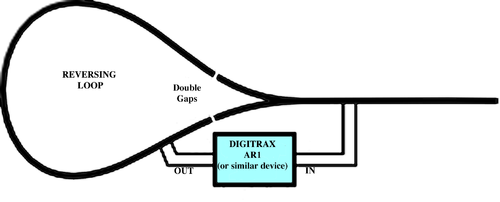Automatic Phase Inversion
Summary: Automatic Phase Inversion corrects phase mismatches between track sections such as cross overs and reverse loops. Also called Auto-reverse, but it does not reverse the direction of a train.
|
See the Video. |
Description
Phase Inversion or Auto Reverse is an electronic feature found in some boosters[1]. If the phase between two power districts controlled by different boosters does not match, a short will occur. To prevent that, both rails are gapped to isolate one power district from the other. When a metal wheel bridges the gap, a phase mismatch causes a short to occur. The auto-reverse circuit detects that event and flips (inverts) the phases so they match. Fleischmann/Roco use the term Auto Inversion which is more accurate in describing what happens.
For adjacent power districts, only one booster should have this feature enabled, preventing an endless loop of phase changes between two boosters.
Digital Command Control does not have signals of different polarity on the rails. The direction of travel is determined by the instructions sent to the multifunction decoder within the locomotive.[2]
Automatic phase inversion devices are available to implement phase matching on a reverse loop. They can be part of a power management device, or a stand-alone unit from suppliers such as Digitrax, DCC Specialties, Lenz, NCE and others.
If a train enters a reverse loop or balloon track, at the turnout's point rails Rail A will connect to Rail B through the turnout's wiring. To prevent this, there must be double gaps on the track loop.
The AR1[3] will detect a phase mismatch across a gap in the rails, such as that found in a reverse loop or turntable, and instantly correct the situation. Any situation where Rail A connects to Rail B results in a short circuit. This also causes a short when two booster districts are out of phase.[4]
Digital Command Control and Polarity
Digital Command Control has no concept of polarity. Despite what many assert, there are no negative voltages present on the rails, nor do the rails possess a specific polarity.
A short occurs when two rails are bridged by a conductor, resulting in current flowing from High to Low.
The correct term, as per the NMRA Digital Command Control standards, is Phase. The rails maintain a phase relationship, where one rail is always the opposite state of the other. Each rail has two distinct states, or phases: High (Energized/On) and Low (0/Off). When one rail is high, the other is low, and vice versa.
The NMRA does define a rail as positive, yet that definition is subjective as it is determined by the direction the locomotive is facing. [5]
Isn't Digital Command Control using Alternating Current
No. Alternating Current is an analog signal with a constantly changing amplitude and polarity, with respect to a ground reference. DCC is digital, it only has two logical states, On and Off.
Digitrax AR1 Auto Reversers. Tips and setup tricks.
Further Reading
- Common Returns are needed to make multiple boosters work properly together. Power management devices as well as auto reversers may require a common return connection as well.
- Reverse Sections
- ↑ This feature is often found on command stations with integrated boosters.
- ↑ Why Inversion? In digital electronics, an inverter is a gate which changes a binary value from one logical state to another. Reverse suggests a change in polarity, which is not applicable to Digital Command Control where there are no polarities, just on and off states. By inversion, a power district or reverse loop can have its phase inverted to match the other signal, preventing a short circuit condition.
- ↑ The AR1 is used to illustrate this process. Other DCC manufactures are available.
- ↑ The booster output terminals are always changing states between High and Low. Current flows from the energized (High) terminal to the other terminal which is held Low (or grounded (0 Volts))
- ↑ The purpose of defining a "positive rail" to maintain compatibility with direct current/analog methods, ensuring a non-DCC equipped locomotive, or one where the decoder is operating in analog mode, moves in the correct direction,
